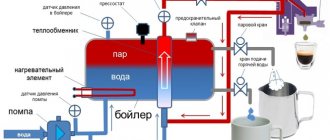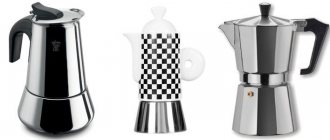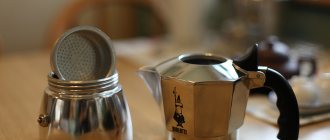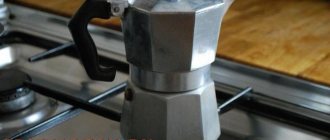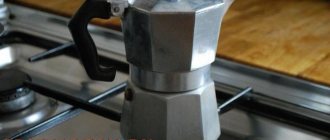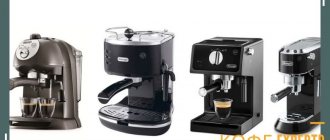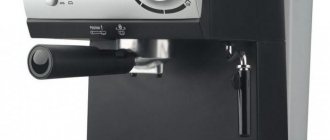The difference between a geyser coffee maker and a regular one
The main differences are how the geyser coffee maker works, how it is serviced, etc.:
- The device prepares coffee using steam.
- After several uses, it is necessary to replace the filters and check the condition of the valve. Cleaning takes quite a long time.
- The cooling rate of the container is much lower than that of a drip container, so safety precautions must be observed.
- Due to the design, preparing the drink will require 6-8 minutes, because the entire bowl is filled.
SOCIAL IMPACT
From a socio-economic point of view, the invention of Moka Express made it possible to drink espresso coffee not only in a cafe or coffee shop, but also at home. This is the main meaning that advertising sought to convey to the buyer. Previously, only the middle class and upper class had the means to have high quality coffee at home, drinking coffee was a social activity for most. The fact is that high-end coffee makers have always been large and expensive machines used by baristas. The creation of Moka, which was small, efficient, easy to use and affordable, allowed people to quickly make good coffee in the comfort of their home. The Moka Express was a replacement for the more primitive coffee makers of the late 19th century, such as the Napoletana and Milanese.
Design and principle of operation
Before using the coffee maker, it is worth understanding its design, which consists of 2 vertically placed tanks connected by a pipe and a cleaning filter.
Inside the system there is a bowl where freshly ground grains are steamed.
It is recommended to monitor the condition of the emergency valve, which is activated in the event of a malfunction. In this case, you should immediately turn off the device.
This mechanism is a bit like a horn mechanism.
However, it is easier to use:
- The lower part is separated and filled with liquid to the drawn mark.
- The ground coffee is poured into the filter, but not compacted.
- The components are reassembled and the coffee maker is turned on or placed on the stove.
To preserve the original condition of the parts, it is advisable to use only medium grinding powder.
Principle of operation
A coffee maker is an electric device for making espresso. Manual or automated control (coffee machines). Hot water is fed into the filter with coffee under pressure from 3 to 15 bar, saturated with aromatic substances. The pressure is created by a boiler (up to 5 bar) or a pump (up to 15 bar). A geyser coffee maker, or moka, is two containers with a coffee filter installed between them. Water is poured into the lower reservoir, the structure is tightly connected and put on fire. The steam generated when water boils displaces the boiling water upward. The pressure causes the hot water to rise through the coffee powder and fill the top bowl.
A geyser coffee maker differs from a carob coffee maker in the way it is heated: it is placed on an electric or gas stove or even on a fire. Electric models of geysers are also available, which can turn off automatically.
- Read more: Electric geyser coffee maker
Types of geyser-type coffee makers
There are 3 types of mechanisms that differ only in the heating method and additional details, but the drink is prepared in the same way.
Electrical
Electrical appliances operate from the network. They are equipped with a switch so that you don’t have to unplug the device from the outlet every time, an indicator light, a thermostat that allows you to control the temperature during cooking, and a noise filter.
The price of these devices is higher when compared with slab products, because the design is complemented by several important details.
They require the least amount of time to brew coffee.
For stove
This is a budget and simple option that requires minimal maintenance, because... To prepare the drink, you just need to fill the containers and put it on the fire. The main thing is to prevent the bottom surface from burning.
For induction hob
The same models are made for induction cookers as for standard surfaces. However, they are more often made of stainless steel and cast iron.
There are both universal coffee makers, suitable for brewing in any conditions, and specialized ones (only for induction hobs).
The manufacturer indicates this feature on the front side of the box.
TYPES AND TRADEMARKS
Traditionally, geyser coffee makers are made of aluminum and heated on a gas or electric stove. Aluminum geyser coffee makers cannot be used on induction cookers, however, stainless steel coffee makers with ferromagnetic inserts are also available. Electric geyser coffee makers are also produced.
"Brikka" is a modified coffee maker manufactured by Bialetti. Its design includes a pressure regulator valve at the top of the nozzle, which allows the steam pressure inside the water compartment to increase, just like in a boiler coffee maker. Since the pressure with this method increases faster than usual (less steam leaks), the time to achieve the desired pressure is reduced. However, the presence of the valve causes the pressure and temperature to increase before the water begins to pass through the ground coffee. As a result, coffee is prepared at elevated pressure and temperature and the finished coffee approaches the quality of espresso coffee.
“Mukka Express” is another modification of the geyser coffee maker, also produced by Bialetti, which has the ability to froth and add milk during the brewing process. The name "Mukka" is a play on words (in Italian - cash cow, mucca). Bialetti also produces several stainless steel geyser coffee makers.
What kind of coffee can you make?
In the geyser model you can prepare the following types of coffee drink:
- Espresso.
- Frappe.
- Latte.
- Cappuccino.
Is it possible to make cappuccino?
Basically, coffee makers are not able to prepare a drink without additional tools.
The exception is the Bialetti Mukka Express model, which is focused only on this product.
In all other cases, it is necessary to use a foam whipper or a whisk, i.e. First the coffee is prepared, then the milk is frothed and poured onto the surface of the drink.
Instructions for use
There are 2 options for using the device, depending on the features of its design.
For electric coffee maker
Sequencing:
- The water is boiled and then poured into the lower bowl.
- Coffee beans and spices are placed in the membrane.
- The structure is being assembled.
- The device is connected to the mains.
- The device turns off when the liquid becomes clear.
For traditional models
Instructions:
- Pure cold liquid is poured into the lower flask.
- A filter with coffee powder is installed without tamping.
- A container is secured into which the finished drink will flow.
- The device is placed on the fire and remains on the stove until all the liquid is in the upper bowl.
Useful tips
To ensure that the use of a geyser-type coffee maker does not cause inconvenience, and the service life is as long as possible, you should follow a number of recommendations:
- Before connecting the device to the network or installing it on a stove, you need to check the correct assembly. Leaks must not be allowed.
- It is forbidden to use whole beans unless the design includes a coffee grinder.
- You need to monitor the temperature so that the taste of the drink does not spoil.
- Due to the high cooking temperature, do not touch the surfaces, as you can get burned.
- After each use, it is recommended to completely disassemble and wash the mechanism. However, the parts must not be cleaned in the dishwasher.
How to prepare a drink in a geyser coffee maker
Usually the coffee maker comes with a user manual, which describes in detail the process of making coffee. Let's look at the process step by step.
- Remove the coffee maker top and filter.
- Pour water into the lower container. It is important to observe the “maximum” mark and not overfill.
- Add ground coffee and spices to the filter. The edges were wiped clean of coffee. Reinstall the filter.
- Completely assemble the coffee maker.
- Put the device on fire or press the electric power button.
- On the stove, coffee is brewed over low heat. Readiness is checked as follows: water stops flowing into the upper container - you can remove the coffee maker from the heat.
- That's it, you can enjoy your drink.
- To prepare the next portion of coffee, the device must be rinsed and the entire algorithm repeated again.
Please note: the device becomes very hot during coffee preparation. If touched, serious burns may occur. You can only take the coffee maker by the handle to pour the drink into cups. It doesn't heat up.
Difficulty in caring for the geyser model
Proper care of your electric coffee maker will increase its operating life.
To prevent the device from breaking, you need to follow a number of rules:
- After completing the preparation of the drink, give the structure time to cool. Then wash it with warm water.
- Monitor the condition of the safety valve. In the event of a malfunction, there is a risk of the device exploding.
- Do not use harsh chemicals to remove residue. It is recommended to replace them with baking soda.
- After cleaning, wipe all parts with a dry cloth.
Where are geyser coffee makers made?
Such coffee makers were initially produced only in Europe, but now popular companies, such as Bialetti, Brikka, etc., locate their factories not only in Italy and Germany, but also in Romania, China, and India. The quality of components made from different materials varies greatly from country to country.
The best Italian companies
Popular Italian companies:
- DeLonghi. It produces household appliances for the home, but the largest range of models is represented by coffee makers. They use artificial intelligence, which completely controls the cooking process.
- Bialetti. Manufactures coffee makers designed to work on gas, induction and electric stoves. All devices are assembled from aluminum and complemented with plastic inserts to prevent burns. The cost of the products is quite low (5-15 thousand rubles).
Spanish producers
The products of the following companies are in demand in Russia:
- Ibili. Sells classic models with an 8-sided body made of aluminum. At the same time, they are covered with a special protective layer, which allows them to be cleaned of dirt even in the dishwasher.
- Ascaso. There is a wide range of coffee makers, but they rarely appear on the domestic market. Therefore, they are often ordered online.
German brands
Common German companies:
- First Austria. Engaged in the production of household appliances for the home. Devices for preparing an invigorating drink have a stylish design with a transparent body, and the ability to adjust the coffee strength. The cooking process takes no more than 4 minutes. However, due to the small size, you can only make 1 cup at a time.
- Rommelsbacher. Advanced computer intelligence monitors the state of liquids in the bowls and regulates the procedure. After cooking, the device turns off automatically.
Other manufacturers
In addition to the above brands, you should pay attention to:
- Endever. Produces standard moki with a small volume of water. Most often, the product is made of polymer aluminum framed with plastic inserts. Surge protection is also built-in.
- Polaris. Produces models of small size, but with high power, which reduces cooking time to 3 minutes. The design feature is a non-heating handle. To make pouring a drink easier, coffee makers are equipped with a narrow neck, which makes them difficult to clean.
Geyser coffee makers: Bialetti and something else
Until recently, we said “geyser coffee maker” and meant Bialetti. This name has long become a household name for the device. This is because the first patent for such a device was received by the Italian entrepreneur Bialetti. He set up production and soon flooded all of Europe with his coffee makers. In everyday life they were called by the name of the manufacturer.
Today, geyser coffee makers are made by many other companies. De'Longhi, BergHOFF and Rondell, Tescoma and Travola, as well as numerous Chinese clones produce geysers of various sizes and designs.
The hexagon-shaped coffee maker is produced only by the Italian company Bialetti. The shape is patented, so from other manufacturers you will see more streamlined contours, or, in extreme cases, slightly outlined edges. Of course, there are fakes on the market, but that, as they say, is a completely different story.
Popular case materials
Often the case is made of thin aluminum, tempered glass, steel, ceramics, etc. Each material has its own advantages and disadvantages, but they do not significantly affect the quality of the finished coffee.
Heat resistant glass
The main bowl is made from it so that a person can visually assess the condition of the liquid. But glass heats up quickly and should not be washed in the dishwasher.
Ceramics
Ceramics are used in traditional models designed for electric and gas stoves. They conduct heat poorly and allow you to create beautiful designs, decorations, etc.
Steel and aluminum
The most practical products in the household are stainless steel products.
They are easy to wash, do not require maintenance, and are durable.
Aluminum is characterized by lightness and resistance to elevated temperatures.
Pros and cons of a geyser coffee maker
When choosing a device for making coffee, you should familiarize yourself with the main advantages and disadvantages of geyser coffee makers. Knowing their strengths and weaknesses will make it much easier to make the right decision.
Following the rules for preparing coffee makes it possible to get a drink that energizes you for the whole day.
Among the positive characteristics of coffee makers used in everyday life are:
- compact dimensions;
- ease of use;
- high speed coffee preparation;
- budget;
- lack of coffee grounds;
- possibility of preparing herbal teas;
- works on any stove;
- the drink has a pleasant aroma;
- does not cause any difficulties during operation.
Despite the whole list of advantages, these devices also have their disadvantages, including:
- you cannot get a very strong drink;
- limitation in the volume of water;
- no grain grinding function;
- difficulties arise when cleaning the device;
- foam in the finished coffee is excluded;
- high risk of burns (do not touch metal parts of the device after brewing coffee).
If you choose a Turk or a geyser coffee maker, then in terms of care, the first option wins; cleaning it is much easier and more convenient.
Benefits of use
Advantages of these coffee makers:
- The operating principle is simple, so anyone can make coffee.
- No need to calculate the proportions of liquid and coffee. Simply fill the containers to the specified level.
- There is no need to constantly monitor the condition of the coffee, because... it doesn't spill out.
- Low cost of the device.
- Compact, allowing you to take the device on hikes.
- The presence of a function for maintaining the temperature of the liquid.
The coffee grounds in the geyser device do not end up in the drink, and its taste is more rich than that prepared in a Turk.
Disadvantages of geyser coffee makers
Design disadvantages:
- Regardless of the desired number of servings, you will have to fill the entire volume of the flasks, otherwise the device will not start working.
- Whole grains cannot be used.
- Do not touch the body due to high temperature.
- The coffee doesn't have a nice crema.
- To clean the device, you need to disassemble all parts.
- It is allowed to use only medium or coarse grains, because... Fine powder clogs the filter.
- The insulating gasket should be checked regularly because When it wears out, the quality of the drink decreases, but replacing the part is problematic.
What to look for when choosing
When purchasing, you need to pay attention to several points:
- Volume (depending on the person’s desires). If the product is purchased for a large family, then it is worth considering models with 4-6 cups, and large coffee makers with 12 servings are suitable for the office. However, the small version is enough for 1 person for 1-2 mugs. At the same time, manufacturers generally mean a 60 ml espresso cup by it.
- Heating method. There are stovetop and electric coffee makers. If the house has a powerful stove, then the first option is better. However, it is advisable to purchase a second one for work. But before purchasing, you need to read the instructions carefully, because... Sometimes there are universal models suitable for standard and induction cookers.
- Material. Most often, products are made of steel and aluminum, which are hygienic, durable and easy to clean. Particular attention should be paid to the quality of the fittings.
- Availability of additional functions. Some models have foam valves, transparent parts in the body, etc.
- Brand. The cost of the product depends on the company, but popular companies produce the most durable products.
A little history
Coffee as a product has been known for a long time, so it was brewed in every possible way! But in the 19th century, when scientific and technical thought began to flow with various inventions, attention was paid to coffee. At the same time, the principle underlying the geyser coffee maker was invented. And it was invented in 1833 by the Englishman Samuel Parker, if Wikipedia is not deceiving us. And we believe her - someone needs to be trusted.
And in the final version, when boiling water passed through the coffee in the coffee maker only once, it was brought to mind and patented by the Italian Alfonso Bialetti already in 1933 AD.
And they began to call it “Moka Express”, which today, in fact, is synonymous with a geyser coffee maker or Bialetti coffee maker .
Today, Bialetti is already a well-known brand that produces “real” coffee makers.
But since the design of the coffee maker is simple, well-studied and does not hide any secrets, everyone who is interested in it produces it under various brands with a different number of edges, with a different spout, and so on.
And it cannot be said that coffee brewed in “not real” coffee makers tastes significantly different from the original Bialetti. The source material - the quality of the coffee bean, how it was ground, how long it was stored and under what conditions - plays a more significant role here. The better it is, the tastier the coffee will be.
The best geyser coffee makers
These coffee makers are selected based on user ratings, build quality, etc.
For any slabs
Products suitable for all types of stoves:
- Lagostina. Works on any stovetop, even ceramic surfaces. You can brew 150 ml of coffee at a time. The main body material is aluminum, which does not change the taste of the drink. The valve is nickel plated, so high humidity does not lead to corrosion. The extended spout makes pouring coffee into mugs easy. The handle is made of thermally insulated plastic, so a person will not get burned.
- Rondell RDS-499. This is a large 300 ml model with a 2-layer metal body with a protective non-stick coating. The thick walls of the main bowl retain heat for a long time. The lid opens automatically when you press the handle. Thanks to the smooth bottom, the coffee maker works on any surface except induction.
Electric models
Electric models:
- Rommelsbacher EKO 376/G. This is the leader in the coffee maker ratings, with an unusual and modern design. The lower bowl is made of thick steel, and the upper bowl is made of heat-resistant glass. The maximum volume reaches 350 ml, which is equivalent to 6 mugs of espresso. The country of manufacture is China, but some parts are supplied from Germany.
- DeLonghi EMK 9 Alicia. The appearance and design of the product corresponds to the classic moka, however, this coffee maker is distinguished by a transparent top flask. Heater power - 450 W. The control consists of 1 power button, because Most of the work is done by artificial intelligence. The tank volume reaches 350 ml. There are several variations of the product in different sizes.
The best budget coffee makers
Coffee makers were selected depending on the price-quality ratio:
- Bialetti Mukka Express. Sold for 3-4 thousand rubles. Works on any cooking surface except induction. The body and flasks are made of aluminum. Durable materials and compactness allow you to take the device to work or on a hike. Using 1 button you can set the mode for preparing cappuccino or coffee with milk. The set includes a special measuring cup.
- Bialetti Rainbow. You can find it in stores for 3,500 rubles. The company logo is located on the front of the structure. The handle does not heat up because... made of materials that conduct heat poorly. The body is covered with colored enamel.
For gas stoves
Suitable for gas stoves:
- Rondell RDA-399. This is a spacious coffee maker designed for 450 ml of liquid. The coating protects the metal from flames and simplifies maintenance. The upper part is equipped with a lid that moves away when pressed. However, the model has a short spout, which means you need to be careful when pouring the drink.
- Lagostina. Costs 2,500 rubles and is made of aluminum. The factory is located in China.
For electric stoves
For electrical surfaces you can buy:
- Bialetti Moka Timer 3. Bowls are made of standard aluminum alloy. They are designed for 3 40 ml espresso mugs. The design is complemented by a timer that will automatically start brewing the drink at the selected time.
- DeLonghi Ariete 1344. The set includes 2 parts: an electric geyser and a cappuccino maker. The coffee maker is designed for 4 mugs. The power of the heating element is 500 W. In this case, the second element can be used as a teapot.
The best according to experts
Experts prefer the following models:
- EndeverCosta 1030. The body consists of light metal with plastic inserts. There is a timer and delayed start function. In addition, the device costs 20% less than competitors with the same set of functions.
- HotterHX 445. Country of origin: Great Britain. The jug is made of heat-resistant glass, but the lower part is made of metal. Volume - 400 ml.
What is a geyser coffee maker - device, operating principle
The design of the geyser coffee maker is quite simple, but compared to the Turkish coffee maker it looks like a smart machine that does half the process itself. Just like the Turk when brewing coffee, you also need to look after it, maybe not so closely.
It consists of two main parts:
- Bottom water compartment
- Top compartment for ready-made coffee
The main parts of the coffee maker are the lower part for water, the upper one for ready-made coffee, and a filter funnel in which ground coffee is kept during preparation. A
cone-shaped funnel-sieve is inserted into the lower part, into which ground coffee is poured to the upper level. At the top there is a metal filter with a gasket, which prevents sediment from getting into the finished drink.
In the upper part there is a filter that prevents coffee particles from getting into the finished drink and a gasket that seals the connection between the upper and lower parts
The connection is sealed with a silicone gasket, which may eventually cease to perform its function, and steam will begin to escape. The water will begin to flow through the coffee with less pressure. In short, you will need to change either the coffee maker or the gasket.
But this is perhaps the only element that may require replacement. With time. If you don’t screw the coffee maker too tightly in the beginning, and the gasket itself is of high quality, then you can relax for several years. With daily use.
The top of the coffee maker has a plastic handle and a lid that hinges on a hinge. You won’t close it at first, as it will be terribly interesting how it all happens inside.
At the top of the geyser coffee maker there is the “geyser” itself, from which coffee extract flows under pressure
The bottom of the coffee maker, like the entire body, is made of aluminum for better heat transfer
The lower part of the coffee maker, from which pressurized water rises through the coffee powder, has such an important safety element as a safety valve to release excess pressure. If suddenly something goes wrong. For example, you took a very fine grind and compacted it well...
The valve itself is a ball that is pressed by a spring. Under the influence of a certain pressure, it compresses this spring, opening the exit of steam to the outside. You can check its operation if you press something sharp into the middle of the hole from the inside. The ball should yield to relatively little force.
Safety valve for releasing excess steam pressure from the outside of the housing
Inside view of the safety valve. A ball is visible, by clicking on which you can check the operation of the valve
Water must be poured into the lower compartment no higher than this valve. In expensive coffee makers there is a mark for water, but in cheap ones the valve itself is this mark. Of course, pouring less is not prohibited.
The operation of a coffee maker is based on excess steam pressure, which is formed when water boils. Pressurized water rises through the spout of the funnel, passes through the coffee and erupts into a geyser at the top of the coffee maker. If you have never been near a volcano and have not observed a geyser eruption live, then you can simply open the lid of the coffee maker and watch this natural process)))
Operating principle of a geyser coffee maker
Comparison table of the best models
| Name | Type | Volume | Material | Weight | average price | Rating |
| Rondell Kafferro RDS-499 | slab | 350 ml | aluminum | 1 kg | 1700 | 4,0 |
| GAT AROMA VIP 103406 | slab | 300 ml | aluminum | 0.59 kg | 2700 | 3,9 |
| Rommelsbacher EKO 376/G | from the network | 300 ml | stainless steel | 1.5 kg | 9100 | 3,8 |
| Bialetti Moka Express 1162 | slab | 120 ml | aluminum | 0.4 kg | 2200 | 4,5 |
| KitchenAid 5KCM0812EOB | from the network | 1000 ml | thermal glass | 2.1 kg | 16990 | 4,2 |
| Endever Costa-1020 | from the network | 300 ml | plastic, aluminum | 0.6 kg | 2399 | 4,3 |
| Rondell Kortado RDA-399 | slab | 450 ml | aluminum | 0.76 kg | 1900 | 47 |
Consumer Reviews
Grigory, 19 years old, Novosibirsk: “I couldn’t even think that Turkish coffee makes the taste of coffee too similar, which is why it’s not always possible to distinguish Americano from espresso.
In a geyser coffee maker, the taste becomes much brighter and more intense. I have never regretted the purchase yet. However, it is quite difficult to care for, and it is not easy to use, which is why the first purchase broke within a month.”
Anastasia, 30 years old, St. Petersburg: “I spent a long time choosing the size of the future coffee maker. The choice fell on the big one, and I made the right decision. I like the ability to brew coffee not for the entire volume of the bowls, but for half, without reducing the pressure.
This is rarely found in traditional versions. Italian models are of the highest quality when compared with Romanian and Chinese ones.”
Violetta, 24 years old, Vladivostok: “Over the course of my history, I have had several coffee makers from Bialetti, they often had defects - leaky housings. Liquid was leaking from the place where the safety valve was inserted, making it impossible to prepare a drink.
Otherwise, there were no complaints against them, because... the containers produced a normal drink. I advise everyone, but you need to carefully inspect the bowls.”
Anna, 35 years old, Nizhny Novgorod: “I bought a Gipfel geyser coffee pot as a gift for my husband. I rarely drink coffee, so it’s difficult to compare the pros and cons with others, but from the coffee machine it comes out completely different, more rich. It's a pity that there is no tasty foam, because... cappuccino is the only thing I like.
There were no complaints about the quality of the design, because... The model did not leak or darken inside. I paid special attention to the presence of an anti-corrosion coating, because last time rust appeared in the fittings.”
Andrey, 46 years old, Moscow: “I’ve been meaning to try something new and unusual for a long time. I chose an Italian coffee pot. It makes a good drink.
At the same time, the taste is not inferior to treats from expensive establishments. However, cleaning the containers after each cup is finished is a hassle. This is the only disadvantage of geyser models. It’s better to buy one for the company.”
Theory: operating principle
The operating principle is the same for any geyser coffee maker.
Water is poured into the lower part of the device. Then screw on the filter, where the ground coffee is poured. The filter has a “leg” and looks like a funnel, the long spout of which descends into the water and reaches almost to the bottom. The top of the filter, filled with coffee, is covered with another removable filter plate. The design of the coffee maker is completed. It is simply screwed to the base with the filter installed. The housing also has a tube leading from the filter into a hollow container. What happens after you place the Italian coffee pot on the stove?
- The water heats up and begins to turn into steam.
- The steam expands and pushes out the remaining water.
- The liquid, “pushed” by the steam, seeks a way out and gradually moves up the tube, which, as we remember, leads straight to the filter with ground coffee.
- The bottom plate of the filter cuts the water so that it is distributed evenly throughout the entire thickness of the ground coffee powder.
- Hot water flows slowly through the ground coffee. Why slow? Because she has to overcome not only a layer of ground grains, but also the force of gravity. The expansion of hot steam helps her in this. We can say that we are observing a curious effect in a geyser coffee maker, when one law of physics helps to cope with the action of another.
- But let's leave physics and get back to our coffee. After the water has seeped through the coffee, it is filtered by the top plate and again enters the tube, but this time in the upper reservoir. He continues his journey along it.
- Having reached the end, the water, enriched with the taste and aroma of coffee beans, but filtered from sediment, is poured from the tube into the hollow container of the coffee pot. This process is slightly reminiscent of a volcanic eruption or the operation of a hot geyser, which is what the coffee maker owes its name. As soon as all the water goes up the tube, the coffee is ready.
This model is called “geyser” only in our country. In all corners of the world it is more often called “moko”, “Bialetti” or “Italian coffee pot”.
